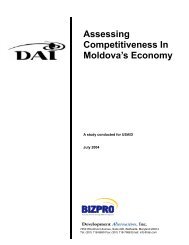Trade and Commercial Law Assessment - Honduras - Economic ...
Trade and Commercial Law Assessment - Honduras - Economic ...
Trade and Commercial Law Assessment - Honduras - Economic ...
Create successful ePaper yourself
Turn your PDF publications into a flip-book with our unique Google optimized e-Paper software.
TRADE AND COMMERCIAL LAW ASSESSMENT DECEMBER 2004<br />
HONDURAS<br />
b.<br />
♦<br />
facilities also need to be upgraded. Currently, Customs does not receive the funding it is<br />
entitled to by law. It now receives somewhat over 2 percent of the revenue collected for<br />
Customs operations. According to Customs officials, the law provides for 3 percent, but<br />
because of national budget problems, Customs does not receive the full amount. An<br />
additional source of funding (beyond what the agency receives from the national budget)<br />
is revenues received from auctions of seized <strong>and</strong> ab<strong>and</strong>oned goods. However, there needs<br />
to be outside funding identified for Customs, in the form of WTO-compliant user fees,<br />
that would be dedicated to Customs modernization, equipment purchase, upgrade of<br />
facilities, increase of employee salaries, <strong>and</strong> incentive awards for excellent service.<br />
Customs officials’ cooperation with the private sector needs improvement. This function<br />
is essential for improved trade facilitation. Customs should have regular meetings with<br />
the private sector to address areas of mutual concern <strong>and</strong> should work with the private<br />
sector to reduce documentary requirements <strong>and</strong> cumbersome procedures. Currently, it<br />
appears that meetings occur only when problems arise.<br />
♦ Training efforts also need improvement. Customs has a training facility, which currently<br />
trains new recruits <strong>and</strong> outside personnel in Customs functions. The facility also provides<br />
training to brokers <strong>and</strong> shippers in Customs procedures. This capacity is important for<br />
any customs agency; however, its utility is undermined by the lack of a professional<br />
customs staff. In addition, training of Customs personnel is wasted because of the regular<br />
turnover. Currently, employees provide all instruction <strong>and</strong> create the materials for the<br />
training. There is a full-time staff of six, including the director,<br />
but there are no full-time<br />
trainers. Technical training in classification, valuation, fraud detection, computer training,<br />
<strong>and</strong> CAFTA requirements is necessary. Improvement in this area is critical. The<br />
European Union (EU) will provide support for a regional training academy in <strong>Honduras</strong><br />
beginning next year. The EU will provide equipment <strong>and</strong> expertise for train-the-trainer<br />
courses.<br />
♦<br />
<strong>Honduras</strong> does not have reliable trade statistics that business can use to make critical<br />
decisions. Statistical data is not readily available <strong>and</strong> is not available in sufficient detail<br />
for credible market analysis.<br />
Customs Operations <strong>and</strong> Procedures<br />
♦ Automation<br />
of vessel manifests is necessary. Currently, no vessel manifests are<br />
downloaded to either the port authority or the Customs automated operating system.<br />
Instead, print copies are given to the port authority, <strong>and</strong> the carriers manually input<br />
manifest data into the Customs system. This manual process leads to input errors, which<br />
can delay cargo.<br />
♦ Examination rates have been reduced, as have the number of discrepancies. However,<br />
conversations held during this assessment indicate that the examination rate is still too<br />
high. (The current rate is approximately 40 percent.) In addition, although discrepancies<br />
are falling, there is no indication whether this is due to increased compliance, lack of<br />
expertise in identifying discrepancies, or nonproductive examination criteria. Cargo<br />
release procedures also are unsatisfactory. Cargo is generally released on the same day<br />
the declaration is filed,<br />
with a maximum 2-day processing time if physical examination is<br />
XI-8

















